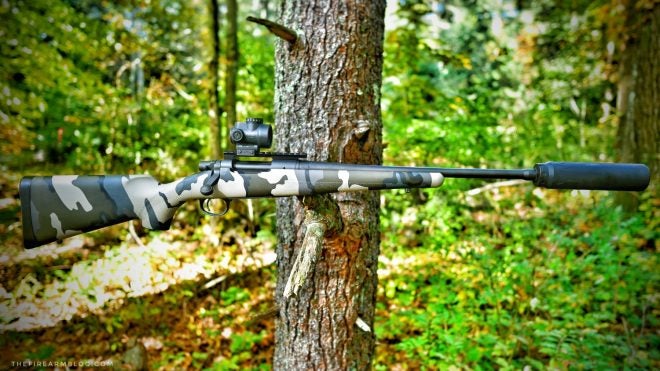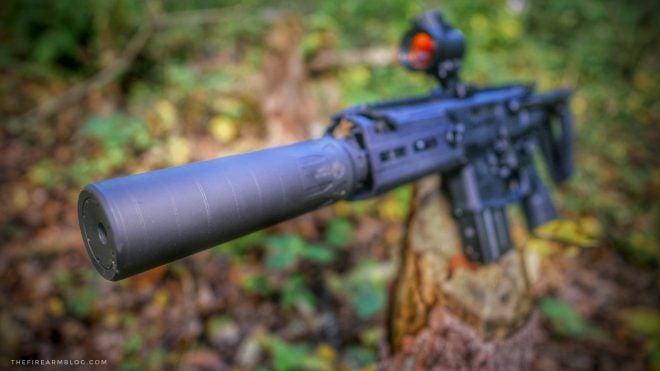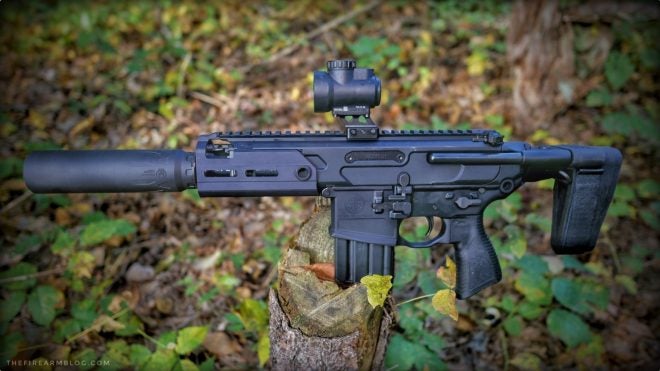No, it is not the weekend quite yet. Whereas we usually like to share our heavy silencer news, information and analysis on TFB’s Silencer Saturday series, today we have a special treat. Kicking off the season of new NFA product announcements is Dead Air Armament with the new Nomad 30 – a lightweight, modular 30 caliber suppressor built to live on everything from a carbine to a hunting rifle. With a variety of mounting solutions, swappable end caps, flash hiders and brakes, the Nomad was designed to be an affordable workhorse that doesn’t add on any unnecessary weight or length. How does it perform? Stick around for TFB’s first shots to find out.

FIRST SHOTS: The New Dead Air Armament Nomad 30
The Dead Air Sandman-S is widely regarded as a suppressor that can take ruthless punishment while still providing superb decibel reduction on multiple platforms. As an alternative, the Nomad 30 was designed for shooters looking for a lighter option who don’t necessarily need the multiple mag-dump capability or sustained heavy rates of fire afforded to its skinnier Sandman cousins.
For years I have preached far and wide that ultimate sound reduction should not be the end goal for every suppressor. To avoid unwieldy and expensive solutions, manufacturers must walk a delicate line between overall length and weight additions and performance. But Dead Air has done a great job in finding the right balance in materials, weight, durability and noise reduction to design a modular silencer with broad usability.

Nomad 30 Specifications:
- Length: 6.5”
- Diameter: 1.735”
- Weight: 14 oz
- MSRP: $916
Looking strictly at the numbers, you can see that the Nomad appears to be a direct competitor to the SilencerCo Omega. In fact with a very similar length and weight, the only remaining physical characteristics that differs between the two is the outer diameter, which is 1.56” for the Omega.

Having only had a short time with the Nomad, I have yet to experiment with all of the modularity options that it offers. It ships with a 5/8×24 direct thread insert, but can be easily swapped to Dead Air’s popular Key–Mo quick detach mounting assembly. The QD Key-Mo system is compatible with both muzzle brakes and flash hiders for easy one hand installation and removal. There is also a 1/2×28 direct thread insert for 5.56mm applications.

Modularity continues at the front of the Nomad with six different muzzle cap options ranging from smaller diameter bores for lesser calibers to flash hider end caps to the E-Brake attachment. I’ll get additional pictures and hopefully some meter numbers with the Nomad wearing the E-Brake for this weekend’s Silencer Saturday.

As you would expect from the Dead Air crew, this silencer is well made and confidence inspiring. Mating surfaces and threads are precise, the welds are flawless and the Cerakote finish is done right. I’ve already gotten the Nomad pretty hot, but I plan on pushing it a little farther to see how the finish holds up under heavier use.
It is deceivingly light in direct thread form. Obviously adding the Key-Mo system and muzzle device will add a few more ounces to your setup.

Before we start talking performance, I wanted to share a section out of the Nomad’s manual regarding decibel metering. As you may or may not know, I’ve recently experimented with my own decibel testing using a variety of models that have passed through the doors of TFB’s Silencer Saturday. And while I still maintain that “metering” is best left to the experts who are designing and manufacturing silencers, proper testing can be a useful tool for basic evaluation. When using the proper equipment and procedures, of course.
At Dead Air Armament, we pride ourselves with both the innovative and scientific process we use to design our products. Part of improving a product is measuring–and you can’t improve what you can’t accurately measure.
While we test across the sound spectrum for frequency and “perceived” sound, we also test for peak sound pressure in decibels (dB) at various locations. We’re keenly interested in balancing at-ear and muzzle results for the best possible shooting experience.
Our published sound testing is performed in accordance with MIL-STD-1474D, which doesn’t exactly provide the best indicator of how something sounds, but it does provide a very conservative and consistent muzzle sound level that can be reliably compared to previous results or known baselines. Our particular system provides very conservative results that you can rely on as accurate and representative of what can be experienced with our products.
Other manufacturers may move the microphone to other locations to provide more favorable readings, such as back behind the muzzle of the suppressor or only at the ear of the shooter. Some even rely on dealer/media sources to measure using systems that typically provide very favorable results. To keep all of this data in context as an end user, you should know this typically results in a bias of several decibels.
We want you to know that our stated results are from our Engineering group, not our Marketing group.
That last line is probably the most important one to remember. Many companies use decibel numbers strictly for marketing campaigns rather than to improve or compare performance to other models. The Nomad’s manual provides a small table of averages for three calibers: 5.56×45, 7.62×51 and 300BLK

Decibel Meter Observations – Dead Air Silencers Nomad 30
Keeping in mind my metering disclaimers above, I am providing some of the first independent tests results for the Nomad-30. I will follow up with a more complete set of 10-shot strings and averages both at the MILSTD Muzzle location as well as at the shooters ear.
Environmental Variables
- Temperature: 75deg
- Humidity: 95 humidity
- Barometric pressure: 30.07Hg
- Meter: B&K 2209 A Weighted
- Host: Remington Model 7 – 300BLK 16”
MILSTD Muzzle
Ammo: Sig Sauer 300BLK 220gr Match
- 128.1
- 125.8
- 128.9
Ammo: Hornady 300BLK Black
- 126.8
- 126.2
- 127.6
- 126.5
Ammo: Hornady Sub-X
- 127
- 128.3
- 128.1
- 129.1
Host: Sig Rattler 5.5”
Location: At Ear
Ammo: Discreet Ballistics 300BLK Target
- 126.1
- 123
- 124.1
- 128.1
- 128
- 125
- 126.5
- 129.4
Ammo: Hornady Sub-X
- 127.5
- 129.1
- 129.4
If you are unfamiliar with decibel meter results, anything under 140dB is usually considered “hearing safe” However I generally consider 130dB to 140dB a ‘hearing protection strongly suggested’ situation. In addition, the human ear is typically incapable of discerning 3dB or less of a difference in noise. So 123.1dB and 125.8dB readings would likely sound the same to shooters and bystanders alike.
With the limited data I observed above, we can reasonably assume that the 300BLK numbers shown in the Nomad’s manual appear to be fairly accurate. While these are solid performance numbers, they aren’t the lowest numbers I’ve ever seen for subsonic 300BLK. But the Nomad is also not the longest or heaviest 30 caliber suppressor on the market. Remember, much like the skills of an Olympic gymnast, building an overall performing silencer is about finding the right balance.

Conclusions:
The Nomad is a suppressor that takes square aim at a large segment of shooters looking for a well rounded silencer. A reasonably light, compact model that is well built, performs solidly and has plenty of modularity options for different hosts. The Nomad is light enough for a bolt action hunting rifle and stout enough for a short barreled AR15 defensive gun.This is an attractive workhorse that won’t disappoint.
I have no idea where the actual street price will land, but the good news is that distributors should have Nomads ready to ship to dealers today (10/11/2018). Which means that if all goes well, a Nomad could call your safe home By February or March of 2019.
Stay tuned to TFB for additional images and analysis of the new Dead Air Nomad. Thanks for reading. Be safe.
Dead Air Armament – Nomad 30
https://deadairsilencers.com/products/
Lightweight. Versatile. Modular. The Nomad-30 exists for the everyday user. Designed to go everywhere you go, mounted on whichever rifle suits your job for the day.
The Nomad-30 is made with 17-4 Stainless Steel and Grade 5 titanium. Weighing in at just 14 ounces, you’ll hardly know it’s there. Featuring an improved high-efficiency baffle design, you’ll appreciate industry-leading sound reduction at the muzzle and minimal first-round-pop.
Don’t let the light weight fool you. It will enjoy long walks in the woods with you, but will also handle every bit of that rigorous training course.

 Your Privacy Choices
Your Privacy Choices

